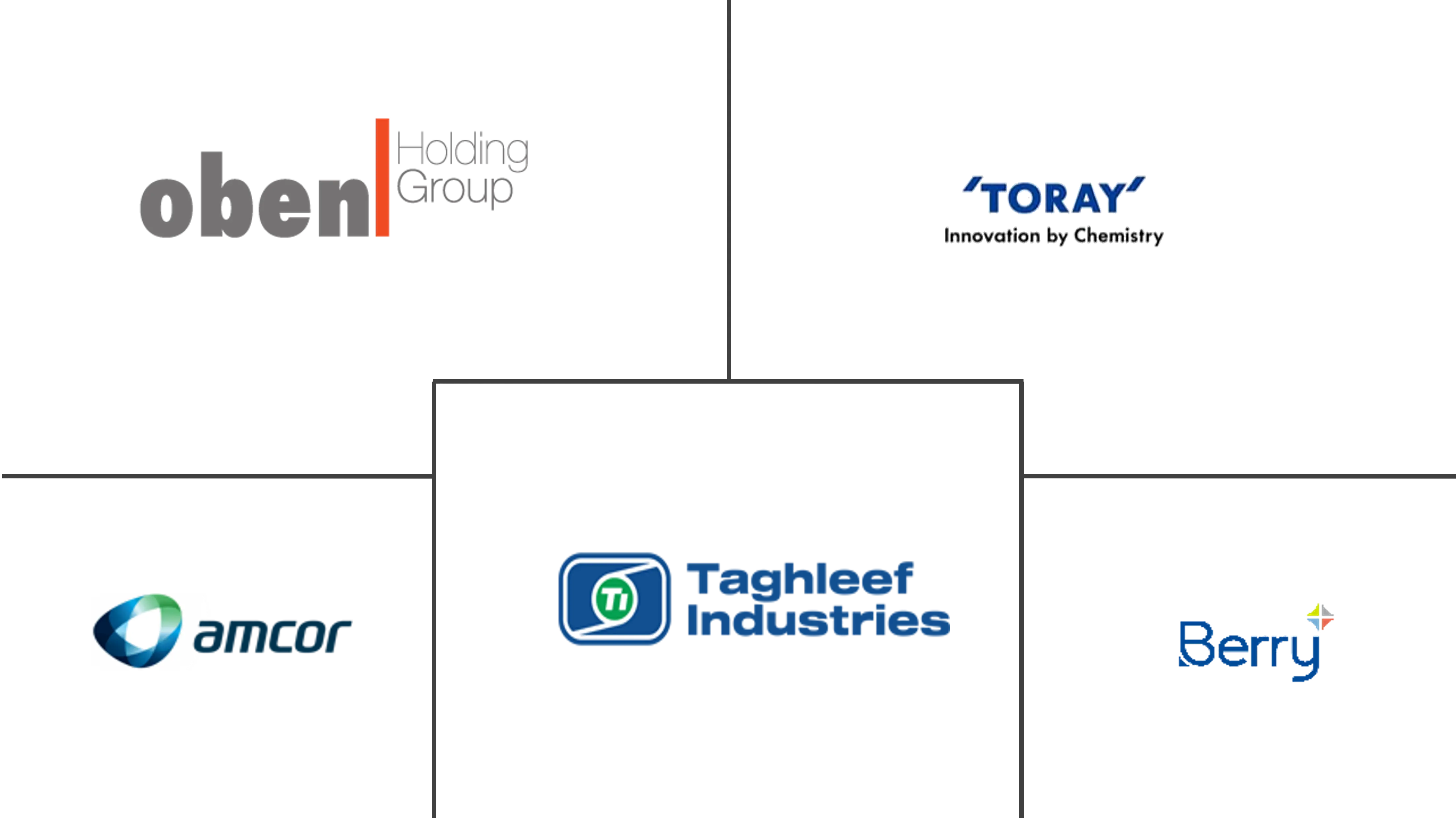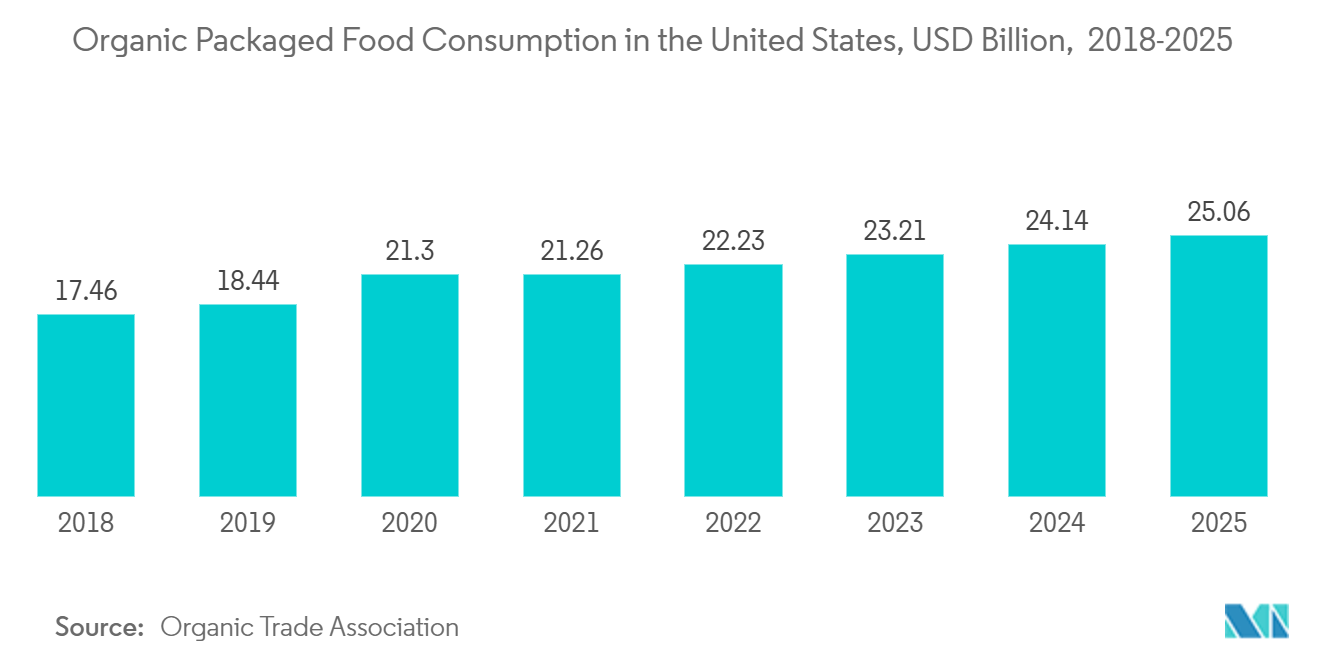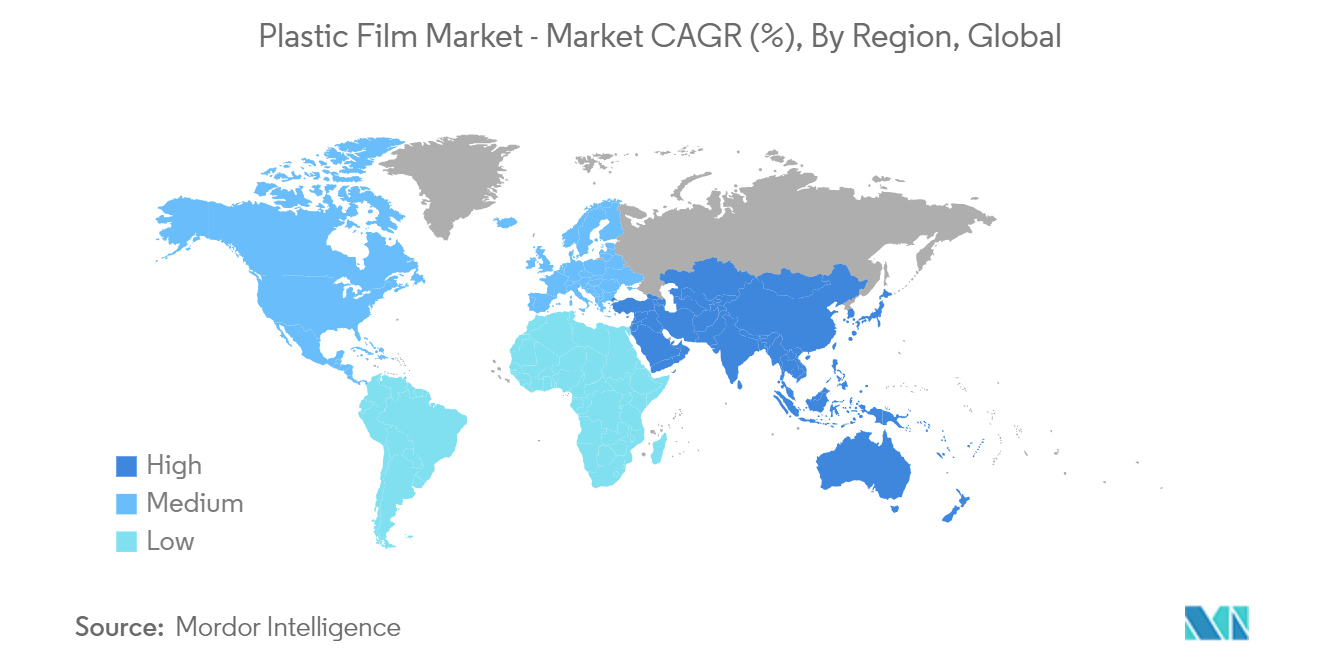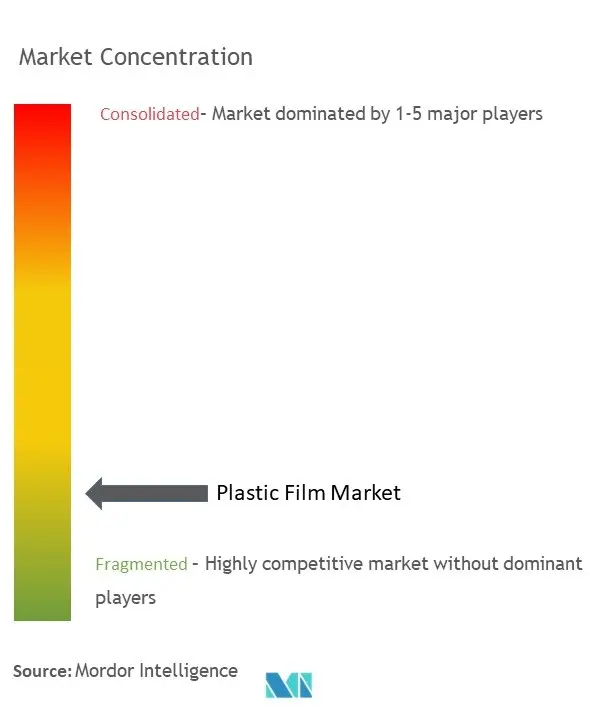Plastic Film Market Size

| Study Period | 2019 - 2029 |
| Market Size (2024) | USD 68.11 Billion |
| Market Size (2029) | USD 79.79 Billion |
| CAGR (2024 - 2029) | 3.22 % |
| Fastest Growing Market | Asia Pacific |
| Largest Market | North America |
| Market Concentration | Low |
Major Players
*Disclaimer: Major Players sorted in no particular order |
Plastic Film Market Analysis
The Plastic Film Market size is estimated at USD 68.11 billion in 2024, and is expected to reach USD 79.79 billion by 2029, growing at a CAGR of 3.22% during the forecast period (2024-2029).
- Plastic film is a continuous, thin layer of plastic material, typically rolled onto a core or cut into sheets. It can be produced from a variety of plastic resins, each possessing distinct physical attributes that cater to specific applications. These films are frequently used in packaging to safeguard and maintain the integrity of products and serve various industrial and consumer purposes. The advantageous properties of plastic films, including transparency, flexibility, durability, and moisture resistance, render them appropriate for numerous applications.
- The ongoing trends in sustainability and lightweighting are leading to a reduction in the thickness of plastic films. This adjustment is necessary to support suppliers facing diminished profit margins due to low polymer prices and meet consumer demands for less packaging driven by environmental considerations and shifts in lifestyle. Heightened awareness of environmental issues and concerns about packaging waste have influenced consumers' purchasing behaviors. In response, brands are developing sustainable packaging options, including biodegradable and water-soluble films, to tackle these environmental challenges.
- The increasing demand from the food industry for various innovative plastic films is expected to drive the market's growth in the future. Alterations in eating patterns, particularly an increasing inclination towards processed foods, are anticipated to enhance the demand for plastic films. Key industry participants are actively manufacturing diverse types of plastics tailored to consumer needs and the perishability of food items. The rising investments in the food industry in countries such as the United States, India, and China are projected to substantially propel the market's growth.
- Moreover, plastic is a highly adaptable material with extensive application in manufacturing packaging systems across multiple industries, including pharmaceuticals, owing to its flexibility, mechanical strength, and stability. Plastic films are particularly suitable for sterile medical and pharmaceutical packaging due to their breathability, clean peel characteristics, and excellent microbial barriers. The increasing investments in the pharmaceutical sector globally are anticipated to propel the market's growth.
- Government initiatives in Germany are anticipated to be crucial in advancing the pharmaceutical plastic packaging market. In 2023, the German government introduced a new Pharmaceutical Strategy, detailed in Strategy Paper 4.0. This strategy aims to strengthen the country's pharmaceutical industry by enhancing research and production capabilities. Additionally, numerous companies in the area are making substantial investments to enhance production activities, which is expected to create opportunities for market participants.
- Similarly, the consistent demand for convenient and nutritious breakfast items is anticipated to drive the expansion of the HDPE films market. The moisture barrier characteristics of HDPE films render them ideal for packaging breakfast cereals, particularly flakes. Furthermore, the growth of e-commerce is contributing significantly to the demand for protective packaging solutions, such as plastic films and wraps. This trend is likely to bolster the market's development in the coming years.
- Numerous companies are making substantial investments in the market, which is anticipated to boost its potential. For example, in November 2023, Oben Group revealed plans to expand its BOPA film operations in the United States, forming a strategic partnership with AdvanSix Inc. for resin supply. Additionally, in August 2023, Amcor PLC enhanced its footprint in the Indian market by agreeing to acquire Phoenix Flexibles. This acquisition is expected to enable the company to increase its capacity to meet demand and incorporate advanced film technology.
- The increasing implementation of strict regulations concerning plastic recyclability is anticipated to impede the market's growth in the coming years. Additionally, the presence of alternative materials in the market may obstruct the market's advancement. Furthermore, as industries adopt the China plus one strategy to mitigate supply chain risks, there is a growing emphasis on expanding operations in India, Vietnam, and other Asian countries. This trend is likely to significantly influence the plastic film market within the region.
Plastic Film Industry Segmentation
The Polypropylene Segment is Expected to Grow Significantly
- Low-density plastic films utilized for packaging are referred to as polypropylene packaging films. These adaptable films are increasingly being embraced by a variety of industries, attributed to their high gloss finish and superior tensile strength. Typically, polypropylene packaging films do not contain acids, plasticizers, or heavy metals, rendering them more environmentally sustainable and suitable alternatives to other plastic films. The rising demand for cast polypropylene (CPP) and biaxially oriented polypropylene (BOPP) films across multiple sectors is expected to propel the growth of this segment.
- CPP has become increasingly popular in various traditional flexible packaging applications, largely due to its exceptional clarity, gloss, heat resistance, and lay-flat properties, which allow it to effectively replace polyethylene. In addition, CPP offers superior tear and impact resistance, enhanced performance in cold conditions, and improved heat-sealing abilities. These packaging solutions contribute to extending the shelf life of food products. Furthermore, the rising demand for convenience foods, driven by evolving lifestyles and busy schedules, has significantly accelerated the market's growth.
- For instance, it is expected that the packaged food industry is likely to thrive, considering the growth of the sector in various regions. The Organic Trade Association projects that the market value of organic packaged food in the United States is expected to rise from USD 23.21 billion in 2023 to USD 25.06 billion by 2025. Consequently, numerous companies are focusing on innovative technologies within the packaging industry, which correlates directly with the rising demand for these packaging solutions.
- BOPP film is known for its robustness, clarity, and longevity, making it suitable for a variety of applications, including food packaging and product labeling. This article examines the complexities of BOPP film, highlighting its key attributes and the production methods involved. Due to its resistance to moisture, optical transparency, and exceptional tensile strength, BOPP film is extensively used in sectors such as medical packaging and food and beverage packaging.
- The swift expansion of e-commerce has led to a heightened demand for packaging that is both tamper-evident and puncture-resistant. BOPP films effectively fulfill these criteria, rendering them suitable for packaging products sold online and aiding in the growth of the market. Countries such as the United States, Germany, India, and China are experiencing notable increases in e-commerce revenues. These critical factors are anticipated to substantially propel the market for BOPP films.
- According to the US Census Bureau, in 2023, it is estimated that retail e-commerce sales in the United States reached USD 275 million, an increase from USD 253 million in 2022. The remarkable rise in e-commerce can be attributed to the increasing incorporation of technology into everyday life. Forecasts suggest a substantial growth in the number of e-commerce users in the United States, projected to rise from 254 million in 2023 to over 316 million by 2028. Furthermore, the presence of major industry players and their investments is anticipated to further propel the growth of the e-commerce sector in the region.
- Moreover, in January 2024, Forop officially launched and is now operating a cutting-edge, multi-layer BOPP line that measures 8.7 meters in width and boasts a line speed of 600 meters per minute, supplied by BrĂĽckner Maschinenbau. This advanced line enhances productivity while simultaneously lowering energy consumption. The substantial investments made by suppliers to enhance BOPP production capabilities are anticipated to stimulate demand significantly.

Asia-Pacific is Expected to Witness the Fastest Growth
- Asia-Pacific is projected to experience the most rapid growth, primarily due to the significant populations of China and India. Data from the World Bank indicates that China's GDP growth reached 5.2% in 2023, driven by a resurgence in consumer demand. In both nations, the rise in disposable income is expected to bolster the expansion of various industries, including food and beverages, pharmaceuticals, pet food, and cosmetics, thereby contributing to the prosperity of the plastic film market.
- The increasing demand for packaged food, coupled with the rise in plastic production, has led many consumers to choose convenient packaging options, thereby driving the expansion of the plastic film packaging market. Significantly, the Indian packaged food sector is projected to double by 2025. As the second-largest food producer globally, India possesses substantial potential to enhance its capabilities and ultimately become the leading food producer in the world.
- The expansion of the plastic film industry in Asia-Pacific is primarily propelled by the food and pharmaceutical packaging sectors. The burgeoning middle class in India, coupled with the rise of organized retailing, is significantly contributing to the growth of the plastic packaging market. Additionally, the swift increase in exports necessitates higher packaging standards to meet international requirements, further stimulating the packaging industry. Consequently, these factors are anticipated to enhance market growth in Asia-Pacific.
- The pharmaceutical sector in Asia-Pacific is experiencing significant growth, largely fueled by an increase in healthcare awareness among the population and the availability of advanced treatment options without geographical limitations. This expanding pharmaceutical market is anticipated to bolster the plastic film industry. As reported by the India Brand Equity Foundation, the Indian pharmaceutical market was valued at USD 49.78 billion in 2023 and is expected to reach USD 130.0 billion by 2030. Furthermore, approximately 25% of the medicine requirements in the United Kingdom are met by the Indian pharmaceutical industry, which also supplies around 40% of the generic medication needs in the United States.
- The region has experienced significant activity in venture capital, mergers and acquisitions, and various expansion strategies, particularly since the post-pandemic era. This trend is a highly encouraging indicator for the growth and development of plastic films in Asia, which are well-positioned to capitalize on ongoing expansion opportunities. For example, in March 2023, Covestro announced its plans to enhance its global production capacity for specialty polycarbonate (PC) films in response to the rising demand in Asia-Pacific and worldwide.
- Moreover, the demand for BOPP films across various countries like India is also expected to witness significant growth. For instance, the rapid expansion of the Indian economy is contributing to significant growth in the BOPP market, driven by the robust development of sectors such as pharmaceuticals, retail, cosmetics, and food and beverages. Additionally, the e-commerce sector represents one of the most substantial applications for BOPP self-adhesive tapes in the nation, owing to their excellent mechanical and optical properties.
- In March 2024, Toppan, in collaboration with Toppan Speciality Films (TSF) based in India, introduced GL-SP, a barrier film utilizing biaxially oriented polypropylene (BOPP) as its substrate, with production and sales commencing in April 2024. This innovative GL-SP film, crafted from BOPP, addresses the increasing demand for sustainable packaging solutions. Its exceptional barrier properties against oxygen and water vapor render it ideal for packaging dry products, while its transparency and reduced thickness contribute to minimizing plastic consumption, effectively catering to a variety of markets. Such notable vendor initiatives in the region are expected to propel the market's growth.

Plastic Film Industry Overview
The plastic film market is fragmented in nature because of the presence of global players and local manufacturers such as Amcor PLC, Berry Global Group Inc., Toray Advanced Film Co Ltd, Oben Holding Group, Taghleef Industries LLC, and Copol International Ltd. Partnerships, mergers, and acquisitions are the prime growth strategies global players adopt to sustain in the market.
- April 2024: Inteplast BOPP Films, a producer of biaxially oriented polypropylene films, partnered with VerdaFresh, a company specializing in sustainable food packaging solutions, to develop a high-barrier flexible film designed to prolong the shelf life of food products while minimizing packaging waste. The initiative, as stated by the company, aims to combat food waste through sustainable packaging methods.
- September 2023: Oben Group announced its agreement to acquire Terphane, a flexible packaging films business part of Tredegar Corporation, which will help the company expand its footprint in the market.
- May 2023: INEO created a thin, inflexible film that is made from over half recycled plastic. This is the first occasion that such a large amount of recycled waste plastic has been employed for packaging products. By combining INEO's polymer savvy with the advanced Machine-Direction Orientation (MDO) technology of Hosokawa Alpine, Recycl-IN resins with more than 50% recycled plastic were converted into polyethylene film.
Plastic Film Market Leaders
-
Amcor plc
-
Berry Global, Inc
-
Toray Advanced Film Co Ltd​
-
Oben Holding Group​
-
Taghleef Industries LLC
*Disclaimer: Major Players sorted in no particular order

Plastic Film Market News
- April 2024: Uflex, a provider of flexible packaging solutions based in India, reached a notable achievement in its strategy for global expansion and innovation. The company has officially begun commercial production of polycondensed polyester chips at its facility located in Panipat, India. Furthermore, Uflex launched a new cast polypropylene (CPP) film line in Russia, with an annual production capacity of 18,000 tonnes. This development highlights Uflex's dedication to vertical integration.
- March 2024: Supply Chain Partners declared its partnership to introduce a new line of premium film packaging composed of 50% recycled plastic. This initiative employs an advanced recycling technique, which complements mechanical recycling, allowing the recycled materials to meet the stringent EU regulatory standards for various applications, including food contact packaging, sensitive contact items, and medical devices.
Plastic Film Market Report - Table of Contents
1. INTRODUCTION
1.1 Study Assumptions and Market Definition
1.2 Scope of the Study
2. RESEARCH METHODOLOGY
3. EXECUTIVE SUMMARY
4. MARKET INSIGHTS
4.1 Market Overview
4.2 Industry Value Chain Analysis
4.3 Industry Attractiveness - Porter's Five Forces Analysis
4.3.1 Bargaining Power of Suppliers
4.3.2 Bargaining Power of Buyers/Consumers
4.3.3 Threat of New Entrants
4.3.4 Threat of Substitute Products
4.3.5 Intensity of Competitive Rivalry
4.4 Market Drivers
4.4.1 High Demand from Various Industries Offers Potential Growth
4.4.2 Increasing Demand for Lightweight Packaging Solution
4.5 Market Challenge
4.5.1 Stringent Government Regulations
5. MARKET SEGMENTATION
5.1 PP Films Market
5.1.1 By Type
5.1.1.1 BOPP
5.1.1.2 CPP
5.1.2 By End-user Industry
5.1.2.1 Food
5.1.2.2 Beverage
5.1.2.3 Pharmaceuticals
5.1.2.4 Industrial
5.1.2.5 Other End-user Industries
5.1.3 By Geography
5.1.3.1 North America
5.1.3.1.1 United States
5.1.3.1.2 Canada
5.1.3.2 Europe
5.1.3.2.1 United Kingdom
5.1.3.2.2 Germany
5.1.3.2.3 France
5.1.3.2.4 Italy
5.1.3.2.5 Spain
5.1.3.2.6 Poland
5.1.3.2.7 Benelux
5.1.3.2.8 Rest of Europe
5.1.3.3 Asia-Pacific
5.1.3.3.1 China
5.1.3.3.2 India
5.1.3.3.3 Japan
5.1.3.3.4 Rest of Asia-Pacific
5.1.3.4 Latin America
5.1.3.4.1 Brazil
5.1.3.4.2 Argentina
5.1.3.4.3 Mexico
5.1.3.4.4 Rest of Latin America
5.1.3.5 Middle East and Africa
5.2 BOPET Films Market
5.2.1 By Type
5.2.1.1 Thin BOPET
5.2.1.2 Thick BOPET
5.2.2 By End-user Industry
5.2.2.1 Packaging and Metallizing
5.2.2.1.1 Food and Beverage
5.2.2.1.2 Pharmaceuticals
5.2.2.1.3 Personal Care
5.2.2.1.4 Other End-user Industries
5.2.3 By Geography
5.2.3.1 North America
5.2.3.1.1 United States
5.2.3.1.2 Canada
5.2.3.2 Europe
5.2.3.2.1 United Kingdom
5.2.3.2.2 Germany
5.2.3.2.3 France
5.2.3.2.4 Italy
5.2.3.2.5 Spain
5.2.3.2.6 Poland
5.2.3.2.7 Rest of Europe
5.2.3.3 Asia-Pacific
5.2.3.3.1 China
5.2.3.3.2 India
5.2.3.3.3 Japan
5.2.3.3.4 South Korea
5.2.3.3.5 Thailand
5.2.3.3.6 Indonesia
5.2.3.3.7 Rest of Asia-Pacific
5.2.3.4 Latin America
5.2.3.5 Middle East and Africa
5.3 PE Films Market
5.3.1 By Material
5.3.1.1 LDPE
5.3.1.2 HDPE
5.3.2 By End-user Industry
5.3.2.1 Food
5.3.2.2 Beverage
5.3.2.3 Agriculture
5.3.2.4 Construction
5.3.2.5 Other End-user Industries
5.3.3 By Geography
5.3.3.1 North America
5.3.3.1.1 United States
5.3.3.1.2 Canada
5.3.3.2 Europe
5.3.3.2.1 United Kingdom
5.3.3.2.2 Germany
5.3.3.2.3 France
5.3.3.2.4 Italy
5.3.3.2.5 Spain
5.3.3.2.6 Rest of Europe
5.3.3.3 Asia-Pacific
5.3.3.3.1 China
5.3.3.3.2 India
5.3.3.3.3 Japan
5.3.3.3.4 South Korea
5.3.3.3.5 Rest of Asia-Pacific
5.3.3.4 Latin America
5.3.3.5 Middle East and Africa
5.4 PVC Films Market
5.4.1 By End-user Industry
5.4.1.1 Food and Beverage
5.4.1.2 Pharmaceuticals
5.4.1.3 Electrical/Electronics
5.4.1.4 Other End-user Industries
5.4.2 By Geography
5.4.2.1 North America
5.4.2.1.1 United States
5.4.2.1.2 Canada
5.4.2.2 Europe
5.4.2.2.1 United Kingdom
5.4.2.2.2 Germany
5.4.2.2.3 France
5.4.2.2.4 Rest of Europe
5.4.2.3 Asia-Pacific
5.4.2.3.1 China
5.4.2.3.2 India
5.4.2.3.3 Japan
5.4.2.3.4 Rest of Asia-Pacific
5.4.2.4 Latin America
5.4.2.5 Middle East and Africa
5.5 Others Plastic Films Types
5.5.1 Polystyrene (PS)
5.5.2 Bio-Based Plastic Films
5.5.3 Polyvinylidene Chloride (PVDC)
5.5.4 Ethylene Vinyl Alcohol (EVOH)
6. COMPETITIVE LANDSCAPE
6.1 Company Profiles
6.1.1 Toray Advanced Film Co. Ltd
6.1.2 Oben Holding Group
6.1.3 Taghleef Industries
6.1.4 Vitopel do Brasil Ltda
6.1.5 Cosmo Films Inc.
6.1.6 Uflex Corporation
6.1.7 Jindal Poly Films Ltd
6.1.8 Dupont Tejin Films
6.1.9 Amcor Plc
6.1.10 Berry Global Inc
6.1.11 Tekni-Plex Inc.
- *List Not Exhaustive
7. INVESTMENT ANALYSIS
8. MARKET OPPORTUNITIES AND FUTURE TRENDS
Plastic Film Industry Segmentation
Plastic film is a flexible packaging solution which is a continuous form of thin plastic material usually wound on a core or cut into sheets. The plastic film is made from different plastic resins based on the requirements and end-user industries.
The plastic film market is segmented by PP films, BOPET films, PE films, PVC films, and other plastic film types, end-user Industries, and geography (North America, Europe, Asia-Pacific, Middle East and Africa, and Latin America). The market sizes and forecasts regarding value (USD) for all the above segments are provided.
| PP Films Market | |||||||||||||||||||||||||||||
| |||||||||||||||||||||||||||||
| |||||||||||||||||||||||||||||
|
| BOPET Films Market | ||||||||||||||||||||||||||
| ||||||||||||||||||||||||||
| ||||||||||||||||||||||||||
|
| PE Films Market | |||||||||||||||||||||||
| |||||||||||||||||||||||
| |||||||||||||||||||||||
|
| PVC Films Market | ||||||||||||||||||||
| ||||||||||||||||||||
|
| Others Plastic Films Types | |
| Polystyrene (PS) | |
| Bio-Based Plastic Films | |
| Polyvinylidene Chloride (PVDC) | |
| Ethylene Vinyl Alcohol (EVOH) |
Plastic Film Market Research Faqs
How big is the Plastic Film Market?
The Plastic Film Market size is expected to reach USD 68.11 billion in 2024 and grow at a CAGR of 3.22% to reach USD 79.79 billion by 2029.
What is the current Plastic Film Market size?
In 2024, the Plastic Film Market size is expected to reach USD 68.11 billion.
Who are the key players in Plastic Film Market?
Amcor plc, Berry Global, Inc, Toray Advanced Film Co Ltd​, Oben Holding Group​ and Taghleef Industries LLC are the major companies operating in the Plastic Film Market.
Which is the fastest growing region in Plastic Film Market?
Asia Pacific is estimated to grow at the highest CAGR over the forecast period (2024-2029).
Which region has the biggest share in Plastic Film Market?
In 2024, the North America accounts for the largest market share in Plastic Film Market.
What years does this Plastic Film Market cover, and what was the market size in 2023?
In 2023, the Plastic Film Market size was estimated at USD 65.92 billion. The report covers the Plastic Film Market historical market size for years: 2019, 2020, 2021, 2022 and 2023. The report also forecasts the Plastic Film Market size for years: 2024, 2025, 2026, 2027, 2028 and 2029.
Plastic Film Industry Report
Statistics for the 2024 Plastic Films market share, size and revenue growth rate, created by ĚÇĐÄvlog´«Ă˝â„˘ Industry Reports. Plastic Films analysis includes a market forecast outlook to 2029 and historical overview. Get a sample of this industry analysis as a free report PDF download.



